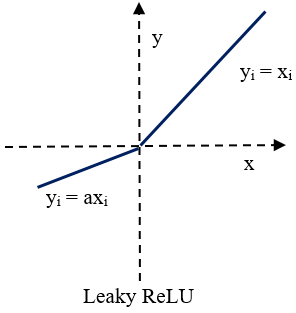LeakyRelu
功能说明
按element做带泄露线性整流Leaky ReLU:
带泄露线性整流函数(Leaky Rectified Linear Unit, Leaky ReLU激活函数),是一种人工神经网络中常用的激活函数,其数学表达式为:

和ReLU的区别是:ReLU是将所有的负值都设为零,而Leaky Relu 是给所有负值赋予一个斜率。下图表示了Relu和vlrelu的区别:


对于Leaky ReLU函数,如果src的值小于零,dst的值等于src的值乘以scalar的值。如果src大于等于零,则dst的值等于src的值。
函数原型
- tensor前n个数据计算
1 2
template <typename T, bool isSetMask = true> __aicore__ inline void LeakyRelu(const LocalTensor<T>& dstLocal, const LocalTensor<T>& srcLocal, const T& scalarValue, const int32_t& calCount)
- tensor高维切分计算
- mask逐bit模式
1 2
template <typename T, bool isSetMask = true> __aicore__ inline void LeakyRelu(const LocalTensor<T>& dstLocal, const LocalTensor<T>& srcLocal, const T& scalarValue, uint64_t mask[2], const uint8_t repeatTimes, const UnaryRepeatParams& repeatParams)
- mask连续模式
1 2
template <typename T, bool isSetMask = true> __aicore__ inline void LeakyRelu(const LocalTensor<T>& dstLocal, const LocalTensor<T>& srcLocal, const T& scalarValue, uint64_t mask, const uint8_t repeatTimes, const UnaryRepeatParams& repeatParams)
- mask逐bit模式
dstLocal和srcLocal使用TensorTrait类型时,其数据类型TensorTrait和scalarValue的数据类型(对应TensorTrait中的LiteType类型)不一致。因此新增模板类型U表示scalarValue的数据类型,并通过std::enable_if检查T中萃取出的LiteType和U是否完全一致,一致则接口通过编译,否则编译失败。接口原型定义如下:
- tensor前n个数据计算
1 2
template <typename T, typename U, bool isSetMask = true, typename std::enable_if<IsSameType<PrimT<T>, U>::value, bool>::type = true> __aicore__ inline void LeakyRelu(const LocalTensor<T>& dstLocal, const LocalTensor<T>& srcLocal, const U& scalarValue, const int32_t& calCount)
- tensor高维切分计算
- mask逐bit模式
1 2
template <typename T, typename U, bool isSetMask = true, typename std::enable_if<IsSameType<PrimT<T>, U>::value, bool>::type = true> __aicore__ inline void LeakyRelu(const LocalTensor<T>& dstLocal, const LocalTensor<T>& srcLocal, const U& scalarValue, uint64_t mask[2], const uint8_t repeatTimes, const UnaryRepeatParams& repeatParams)
- mask连续模式
1 2
template <typename T, typename U, bool isSetMask = true, typename std::enable_if<IsSameType<PrimT<T>, U>::value, bool>::type = true> __aicore__ inline void LeakyRelu(const LocalTensor<T>& dstLocal, const LocalTensor<T>& srcLocal, const U& scalarValue, uint64_t mask, const uint8_t repeatTimes, const UnaryRepeatParams& repeatParams)
- mask逐bit模式
参数说明
|
参数名 |
描述 |
|---|---|
|
T |
操作数数据类型。 |
|
U |
scalarValue数据类型。 |
|
isSetMask |
是否在接口内部设置mask。
|
|
参数名称 |
类型 |
说明 |
|---|---|---|
|
dstLocal |
输出 |
目的操作数。 类型为LocalTensor,支持的TPosition为VECIN/VECCALC/VECOUT。 Atlas推理系列产品AI Core,支持的数据类型为:Tensor(half/float) Atlas A2训练系列产品/Atlas 800I A2推理产品,支持的数据类型为:Tensor(half/float) Atlas 200/500 A2推理产品,支持的数据类型为:Tensor(half/float) |
|
srcLocal |
输入 |
源操作数。 类型为LocalTensor,支持的TPosition为VECIN/VECCALC/VECOUT。 数据类型需要与目的操作数保持一致。 Atlas推理系列产品AI Core,支持的数据类型为:Tensor(half/float) Atlas A2训练系列产品/Atlas 800I A2推理产品,支持的数据类型为:Tensor(half/float) Atlas 200/500 A2推理产品,支持的数据类型为:Tensor(half/float) |
|
scalarValue |
输入 |
源操作数,数据类型需要与目的操作数Tensor中的元素保持一致 Atlas推理系列产品AI Core,支持的数据类型为:half/float Atlas A2训练系列产品/Atlas 800I A2推理产品,支持的数据类型为:half/float Atlas 200/500 A2推理产品,支持的数据类型为:half/float |
|
calCount |
输入 |
输入数据元素个数。 参数取值范围和操作数的数据类型有关,数据类型不同,能够处理的元素个数最大值不同。 矢量计算单元,每个迭代读取连续256 Bytes数据进行计算,通过多次迭代完成所有数据的读取与计算。所以当操作数为16位时,calCount∈[1,128*255],255表示迭代次数的最大值,128表示每次迭代内能够处理128个16位数据;当操作数为32位时,calCount∈[1,64*255],64表示每次迭代内能够处理64个32位数据。 |
|
mask |
输入 |
|
|
repeatTimes |
输入 |
重复迭代次数。 矢量计算单元,每次读取连续的256 Bytes数据进行计算,为完成对输入数据的处理,必须通过多次迭代(repeat)才能完成所有数据的读取与计算。repeatTimes表示迭代的次数。 |
|
repeatParams |
输入 |
元素操作控制结构信息,具体请参考UnaryRepeatParams。 |
返回值
无
支持的型号
Atlas推理系列产品AI Core
Atlas A2训练系列产品/Atlas 800I A2推理产品
Atlas 200/500 A2推理产品
注意事项
- 使用tensor高维切分计算接口时,节省地址空间,开发者可以定义一个Tensor,供源操作数与目的操作数同时使用(即地址重叠),相关约束如下:
- 对于单次repeat(repeatTimes=1),且源操作数与目的操作数之间要求100%完全重叠,不支持部分重叠。
- 对于多次repeat(repeatTimes>1),操作数与目的操作数之间存在依赖的情况下,即第N次迭代的目的操作数是第N+1次的源操作数,不支持地址重叠的。
- 操作数地址偏移对齐要求请参见通用约束。
调用示例
- tensor高维切分计算样例-mask连续模式
#include "kernel_operator.h" class KernelBinaryScalar { public: __aicore__ inline KernelBinaryScalar() {} __aicore__ inline void Init(__gm__ uint8_t* src, __gm__ uint8_t* dstGm) { srcGlobal.SetGlobalBuffer((__gm__ half*)src); dstGlobal.SetGlobalBuffer((__gm__ half*)dstGm); pipe.InitBuffer(inQueueSrc, 1, 512 * sizeof(half)); pipe.InitBuffer(outQueueDst, 1, 512 * sizeof(half)); } __aicore__ inline void Process() { CopyIn(); Compute(); CopyOut(); } private: __aicore__ inline void CopyIn() { AscendC::LocalTensor<half> srcLocal = inQueueSrc.AllocTensor<half>(); AscendC::DataCopy(srcLocal, srcGlobal, 512); inQueueSrc.EnQue(srcLocal); } __aicore__ inline void Compute() { AscendC::LocalTensor<half> srcLocal = inQueueSrc.DeQue<half>(); AscendC::LocalTensor<half> dstLocal = outQueueDst.AllocTensor<half>(); uint64_t mask = 128; half scalar = 2; // repeatTimes = 4, 128 elements one repeat, 512 elements total // dstBlkStride, srcBlkStride = 1, no gap between blocks in one repeat // dstRepStride, srcRepStride =8, no gap between repeats AscendC::LeakyRelu(dstLocal, srcLocal, scalar, mask, 4, {1, 1, 8, 8}); outQueueDst.EnQue<half>(dstLocal); inQueueSrc.FreeTensor(srcLocal); } __aicore__ inline void CopyOut() { AscendC::LocalTensor<half> dstLocal = outQueueDst.DeQue<half>(); AscendC::DataCopy(dstGlobal, dstLocal, 512); outQueueDst.FreeTensor(dstLocal); } private: AscendC::TPipe pipe; AscendC::TQue<AscendC::QuePosition::VECIN, 1> inQueueSrc; AscendC::TQue<AscendC::QuePosition::VECOUT, 1> outQueueDst; AscendC::GlobalTensor<half> srcGlobal, dstGlobal; }; extern "C" __global__ __aicore__ void binary_scalar_simple_kernel(__gm__ uint8_t* src, __gm__ uint8_t* dstGm) { KernelBinaryScalar op; op.Init(src, dstGm); op.Process(); } - tensor高维切分计算样例-mask逐bit模式(本样例中只展示Compute流程中的部分代码。如果您需要运行样例代码,请将该代码段拷贝并替换上方样例的Compute函数中粗体部分即可。)
uint64_t mask[2] = { UINT64_MAX, UINT64_MAX }; int16_t scalar = 2; // repeatTimes = 4, 单次迭代处理128个数,计算512个数需要迭代4次 // dstBlkStride, srcBlkStride = 1, 每个迭代内src0参与计算的数据地址间隔为1个datablock,表示单次迭代内数据连续读取和写入 // dstRepStride, srcRepStride = 8, 相邻迭代间的地址间隔为8个datablock,表示相邻迭代间数据连续读取和写入 AscendC::LeakyRelu(dstLocal, srcLocal, scalar, mask, 4, {1, 1, 8, 8}); - tensor前n个数据计算样例(本样例中只展示Compute流程中的部分代码。如果您需要运行样例代码,请将该代码段拷贝并替换上方样例的Compute函数中粗体部分即可。)
half scalar = 2; AscendC::LeakyRelu(dstLocal, srcLocal, scalar, 512);
输入数据(src0Local): [1. 2. 3. ... 512.] 输入数据 scalar = 2. 输出数据(dstLocal): [1. 2. 3. ... 512.]